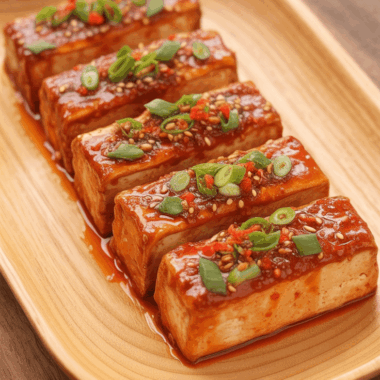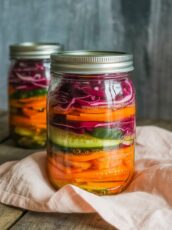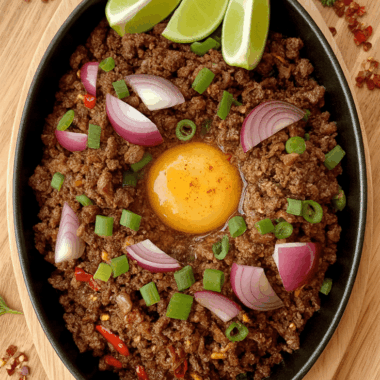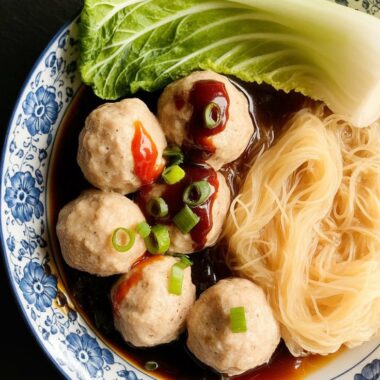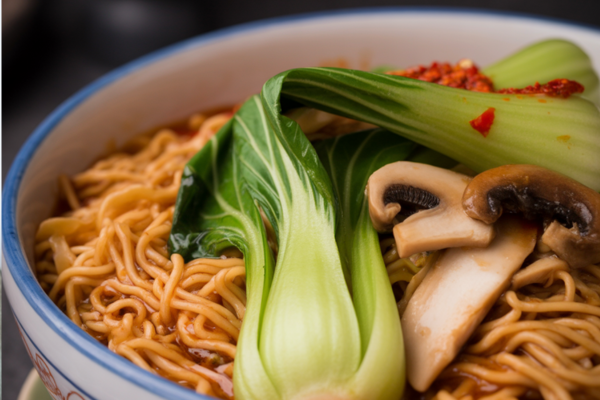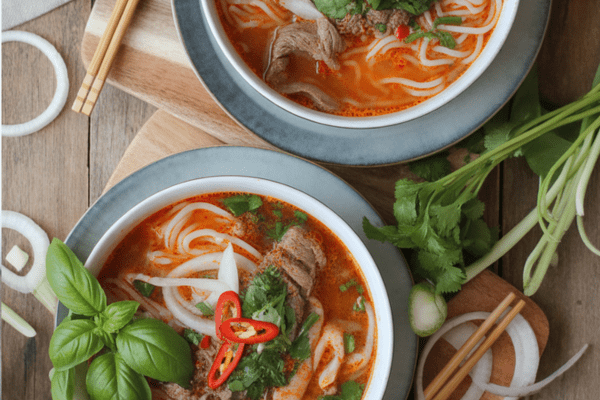I’ve lost count of the number of times I’ve sat in a small Taiwanese restaurant, slurping up spicy beef noodle soup and thinking—I wish I could make this at home. I’m happy to say that after plenty of experiments (and a few stubborn family debates at the butcher counter), I finally nailed down a version I love.
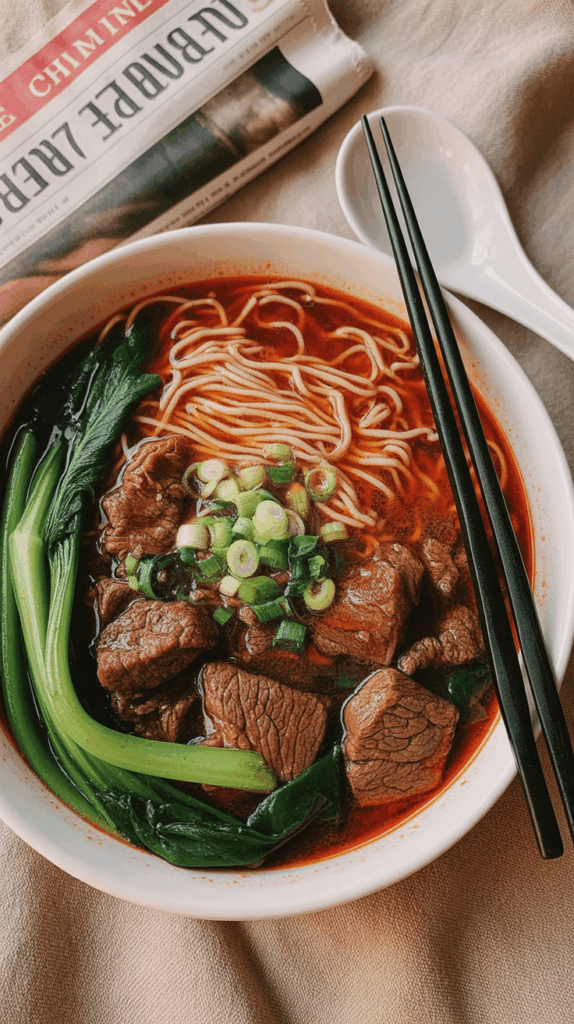
This recipe is cozy, deeply savory, and honestly feels like a hug in a bowl. Best part? You can do it in the Instant Pot to save time or on the stovetop the old-fashioned way.
What Makes This Beef Noodle Soup So Special
For me, this soup is the perfect balance of tender beef, richly spiced broth, springy noodles, and crisp green bok choy. And let’s not forget those essential pickled mustard greens that bring the bowl to life with a salty, tangy kick.
I’ve been served versions of this with a dozen different broths—some light and clear, some nearly black and sticky with spice. My version leans toward the darker, richer end. It’s the kind of broth you’d sip slowly, grateful for the chill outside.
I like to have a pot of this simmering on a weekend afternoon, filling the house with the warm scent of star anise, soy sauce, and ginger. If you’ve never made beef noodle soup from scratch before, you’re in for a treat.
Why I Used to Avoid Making It—and What Changed
I’ll be honest. I used to think this was too much work. All those spices, long simmering times, tough cuts of beef that never seemed to soften.
When my Instant Pot arrived, one of the first things I tried was this recipe. It felt like cheating—getting deeply flavorful, falling-apart beef in a fraction of the usual time.
But don’t worry if you don’t have an Instant Pot. I’ll share the stovetop method too. It just takes more patience (and maybe a good podcast or two while it simmers).
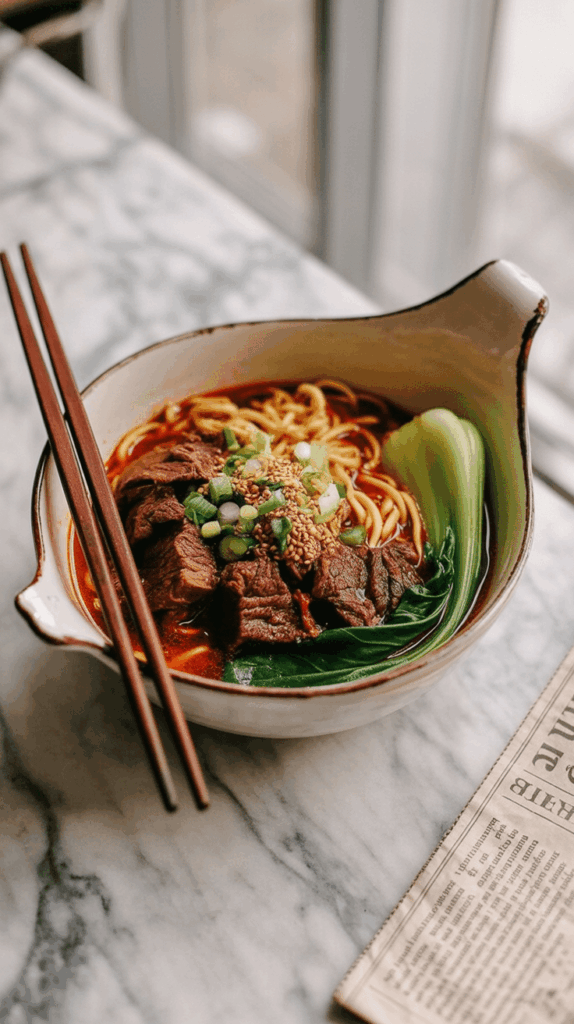
My Favorite Cut of Beef (and a Family Debate)
We once had a serious, near-comic argument in a small butcher shop over which cut to buy. One of those “people are staring” moments.
I love beef shank for this. It’s fatty, has rich collagen, and breaks down beautifully with enough time or pressure. My family is split: some like fatty chuck, others short rib. The truth is, you can use what you like, but shank gives you that classic, slightly sticky, deeply beefy result that clings to the noodles.
I also love that you don’t need bones. The meat alone will give your broth everything it needs. I used to fret about sourcing marrow bones at odd hours—no more.
What You’ll Need
Here’s my short list of what I keep on hand:
- Beef shank (or chuck, if you like)
- Fresh ginger and garlic
- Green onions and regular onions
- Tomatoes (for sweetness and body)
- Spicy bean paste (doubanjiang) for a real kick
- Soy sauce, Shaoxing wine, tomato paste
- Sugar for balance
- Dried chilies
- A packet of Chinese aromatic herbs (lu bao) if you have it
I like that nothing here feels impossible to find, even at a smaller grocery store if you swap the herb packet for a few star anise, cinnamon sticks, and dried orange peel.
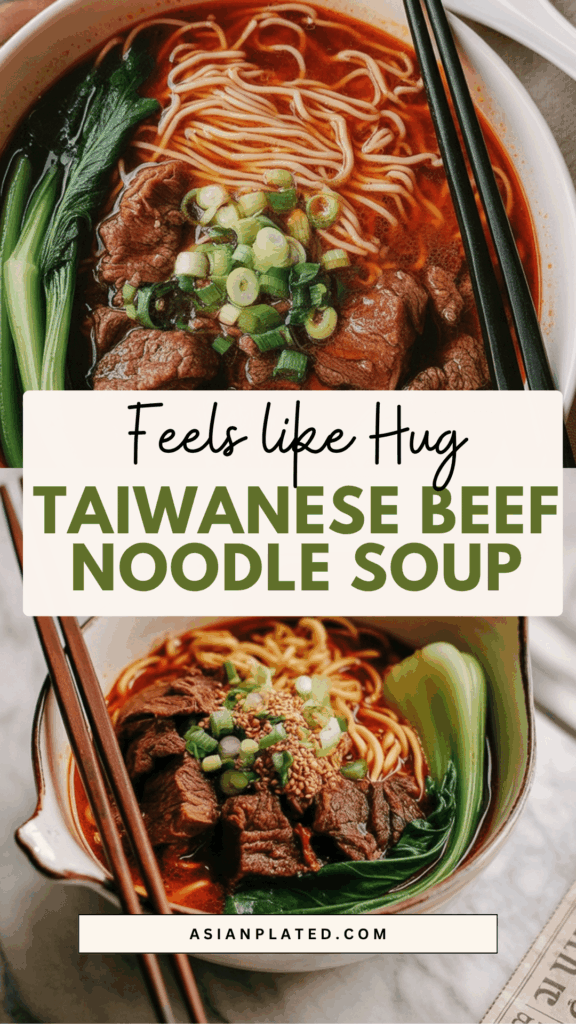
Let’s Talk About Cooking This in an Instant Pot
If you have one, this is the easiest path to deeply flavored, meltingly tender beef.
You’ll first blanch the beef briefly to get rid of scum and impurities. This is an old-school trick my grandmother insisted on, and honestly, it’s worth the extra minute.
Then you sauté your aromatics right in the pot. Ginger, garlic, scallions, onions—let them get golden and fragrant.
Tomatoes and chilies go in next for that base layer of heat and sweetness.
Finally, the beef returns, along with all the pastes, sauces, and wine. Add water, your spice bundle if you have one, close it up, and walk away.
100 minutes on the Meat/Stew setting later, you’ll open the lid to find that perfect dark, glossy broth and beef that practically falls apart on your spoon.
This method honestly feels like kitchen magic after years of babysitting stock pots.
Stovetop Method for the Traditionalists
If you’re in no rush, use your biggest pot and bring everything together just the same way. Instead of pressure cooking, keep it at a gentle simmer for around 3 hours.
I like to check once in a while to see how the beef is doing, adding a splash of water if the broth reduces too much.
The longer it goes, the richer the flavor. I used to make a double batch so I could eat it for lunch all week.
My Tips for the Best Results
- Blanch your beef first: Don’t skip it. It keeps your broth clean and clear.
- Sauté the aromatics: Give them time to caramelize. This step builds deep flavor you won’t get if you just throw it all in.
- Don’t overfill the pot: If you’re using an Instant Pot, keep it under the max fill line. Safety first.
- Spicy bean paste: This is my secret weapon. It brings a savory, spicy depth that really makes the soup taste authentic.
- Use what you have: Don’t stress about fancy spice packets. A couple of star anise and a cinnamon stick do wonders.
Serving It Like I Do at Home
I always boil my noodles separately so they stay springy. Just follow the package instructions.
In the last minute, I throw bok choy into the same pot to blanch it bright green and tender.
Then I layer each bowl: noodles first, ladle of beef and broth next, then bok choy on the side.
I finish with chopped cilantro, scallions, and that classic pickled mustard green. I usually buy it pre-seasoned and spicy from the Asian grocery—it’s ready to eat and adds such a sharp, salty bite.
If you have the milder canned version, I warm it in a pan with oil, chopped dried chilies, and a pinch of sugar until it’s fragrant. That quick sauté is all it needs.
Make-Ahead and Storage Advice
This soup is even better the next day. The flavors deepen overnight.
I let it cool, then store it in the fridge in airtight containers for up to 4 days. It also freezes well. I portion it out in freezer containers so I can have a bowl whenever the craving hits.
If you’re planning on freezing it, I suggest keeping the noodles separate and boiling fresh ones when you reheat the broth.
Common Questions I Get
Can I use other cuts of beef?
Absolutely. Chuck, short rib, even oxtail if you’re up for it. The cooking time might need small tweaks, but any cut with good marbling will work.
Do I have to use doubanjiang?
It’s traditional for the spicy, fermented flavor, but you can skip or replace it with another chili paste. The result will be different, but still good.
Can I make it less spicy?
Just reduce the chilies or skip the doubanjiang altogether.
What if I can’t find mustard greens?
Honestly, the soup is still wonderful without them. But if you can find them, they’re worth it for the salty-tangy balance.
Taiwanese Beef Noodle Soup
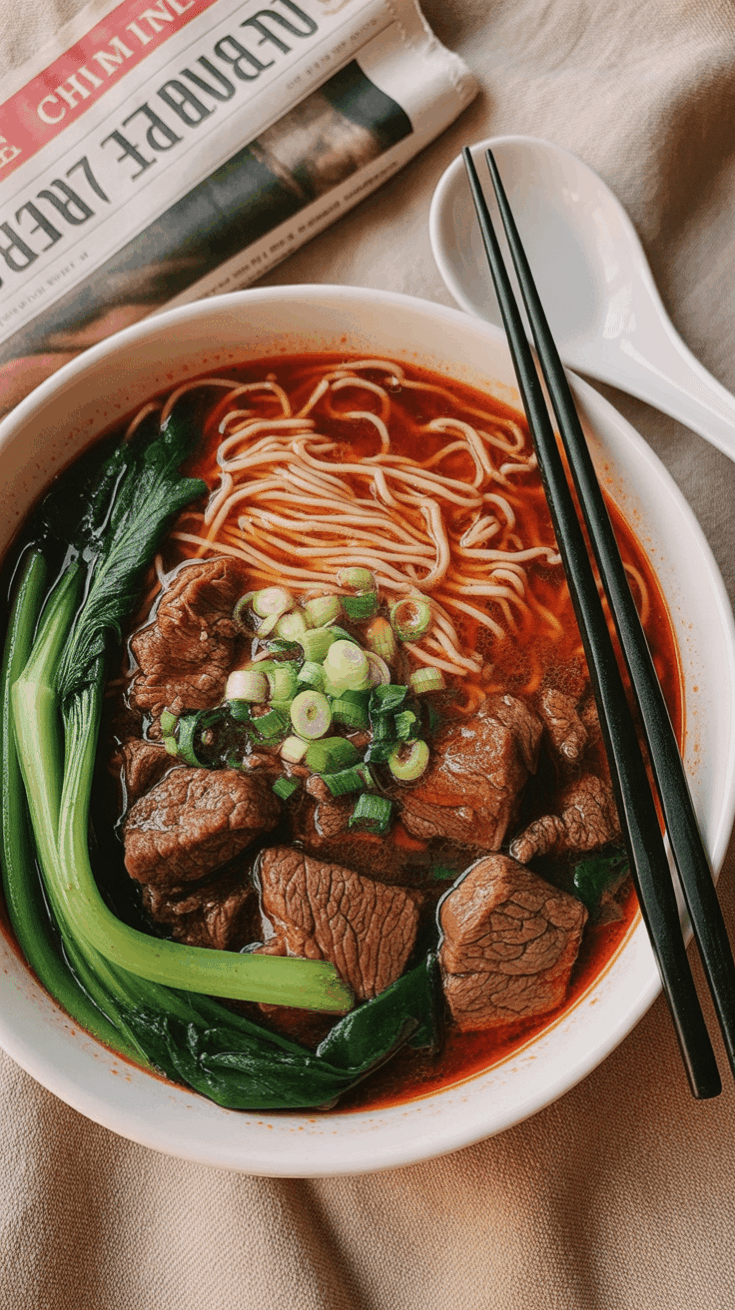
There’s something incredibly comforting about a bowl of Taiwanese Beef Noodle Soup. With rich, spicy broth, melt-in-your-mouth beef, tender greens, and slurp-worthy noodles, this dish hits all the right notes.
Ingredients
- 2 tablespoons oil
- 2 tablespoons spicy bean paste (doubanjiang)
- 1 tablespoon tomato paste
- 2 teaspoons sugar
- ½ cup soy sauce
- ½ cup Shaoxing wine
- 8 cups water
- 3 pounds beef shank, cut into large chunks
- 1 medium onion, cut into wedges
- 1 ripe tomato, quartered
- 6 cloves garlic, smashed
- 1 thumb-sized piece of ginger, smashed
- 3 scallions, cut into 2-inch pieces
- 4 dried red chilies, halved
- 1 spice sachet or lu bao (see below for DIY)
- 32 oz fresh wheat noodles
- Bok choy – a small handful per serving
- Fresh cilantro, finely chopped
- Scallions, finely chopped
- Pickled mustard greens (also called snow vegetable), to taste
For homemade spice sachet (tie in cheesecloth):
- 4 star anise
- 1 Chinese cinnamon stick
- 3 bay leaves
- 1 tbsp fennel seeds
- 1 tbsp cumin seeds
- 1 tsp coriander seeds
- 2 tbsp Sichuan peppercorns
- ¼ tsp five-spice powder
- ¼ tsp black pepper
Instructions
- Start with a quick beef blanch: Bring a large pot of water to a rolling boil. Add the beef shank pieces and let them boil for a minute or so to remove any impurities. Drain immediately and rinse the meat under cool water. Set aside.
- Build your flavor base: Switch on the sauté function on your Instant Pot. Add the oil and toss in the ginger, garlic, scallions, and onions. Let everything sizzle and develop some color. Once the onions soften and turn translucent, stir in the tomatoes and chilies.
- Combine the aromatics and sauces: Add the blanched beef to the pot, followed by the tomato paste, spicy bean paste, sugar, soy sauce, and Shaoxing wine. Stir everything together until well coated and fragrant.
- Pour in the broth: Add 8 cups of water along with your herb sachet (or lu bao). Check the fill line to ensure you’re within the safe limit—this should bring you to about the 10-cup mark in an 8-quart Instant Pot.
- Pressure cook: Secure the lid and ensure the vent is sealed. Set the Instant Pot to “Meat/Stew” and cook for 100 minutes. If using a regular pot on the stove, simmer gently over low heat for 3–4 hours, partially covered, until the beef is tender and the broth is rich.
- Prep the noodles and greens: When your soup is almost ready, boil your noodles according to package instructions. During the final minute of cooking, toss in the bok choy to blanch it briefly.
- Assemble your bowls: In each bowl, place a portion of noodles, top with a few pieces of bok choy, and ladle over the hot broth and beef. Finish with generous spoonfuls of chopped scallions, cilantro, and pickled mustard greens. For extra kick, use the pre-spiced variety straight from the package—or stir-fry plain ones with oil, chili, and a touch of sugar.
Nutrition Information:
Yield: 10 Serving Size: 1Amount Per Serving: Calories: 518Total Fat: 14gSaturated Fat: 4gTrans Fat: 0gUnsaturated Fat: 8gCholesterol: 107mgSodium: 851mgCarbohydrates: 42gFiber: 6gSugar: 6gProtein: 55g
Asianplated.com, occasionally offers nutritional information for recipes contained on this site. This information is provided as a courtesy and is an estimate only. This information comes from online calculators. Although allchickenrecipes.com attempts to provide accurate nutritional information, these figures are only estimates.
Final Thoughts
If you’ve ever felt intimidated by making Taiwanese Beef Noodle Soup at home, I hope this convinces you to give it a try. It’s warm, filling, and the sort of meal that makes people linger around the table for second helpings.
Whether you use the Instant Pot or go old-school on the stovetop, you’ll end up with something you can be proud of.
Try other Taiwanese recipes:


